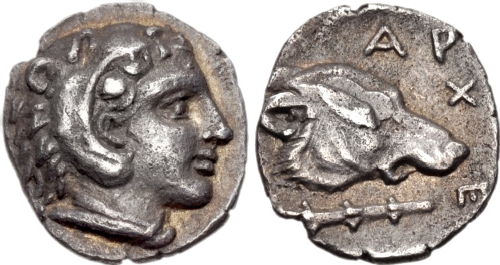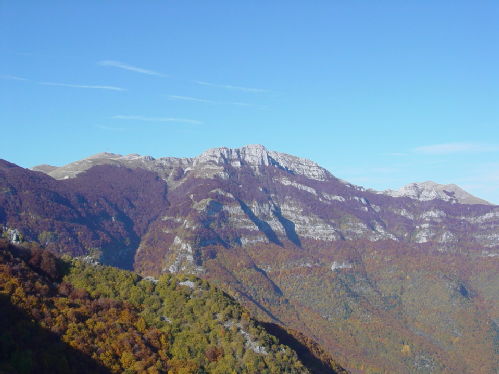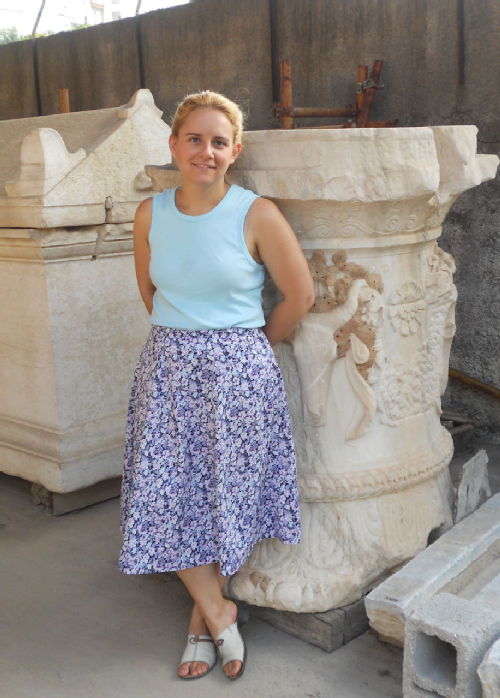All 2 entries tagged Macedonia
No other Warwick Blogs use the tag Macedonia on entries | View entries tagged Macedonia at Technorati | There are no images tagged Macedonia on this blog
December 01, 2016
King Archelaos’ wolf

This minuscule silver coin was struck in Macedonia at all probability in Aigai, the ancient capital city of the Kingdom, late in the 5th century BC. It is an obol, a silver fraction, struck during Archelaus’ reign (413-399 BC). The types of the coin are worthy of careful examination since they shed light to the pursuits and exploits of the Macedonian kings as well as the ideology of their time.
During the 5th century BC the kingdom of Macedonia was slowly emerging from the periphery of the Classical world, gradually transforming into the dominant imperial state built by Alexander the Great. The circumstances that led to the beginnings of coinage in Macedonia and Thrace are hard to reconstruct. The tribes in the area of mount Pangaion and colonies of the city states of Southern Greece first produce coinage sometime late in the sixth century BC, the complex pattern of which presents many riddles to modern-day numismatists. Obviously the rich precious metal resources of the area, especially the mines of Mount Pangaion, played an important role. The tribute inflicted by the Persian king gave the impetus.
 |
| Mount Pangaion (Wikimedia) |
After the retreat of the Persians the king of Macedon, Alexander I, the so-called Philhellene who had cleverly sided with the winners, established his position in the world of the Greek City States. According to Herodotus, Alexander simultaneously proclaimed his Greek and Macedonian connections. He also highlighted his (and his dynasty’s) glorious ancestry from the Temenids. As a result he was granted the right to participate in the Olympic Games (Herodotus 5.22.1-4 and 8.137-139). Thucydides confirms this (2.99.3). A dedicatory inscription to “Heracles of our fathers” (ΗΡΑΚΛΗΙ ΠΑΤΡΩΙΩΙ) found in the tholos of the Palace in Aigai also bears testimony to this legend. But it was only under Archelaus, Alexanders I’s grandson, that Heracles took his place on the obverse of the silver issues, a practice that it would become common for all his successors.
Alexander I’s regal coinage continued the preceding tribal coinages as far as weight, types and denominations were concerned. Major innovations were the use of two different coin standards for the octadrachms and the tetradrachms, and the use of heavy and light tetrobols that belonged to these two distinct weight systems. The obvious reason was the need to ensure interchangeability of the Macedonian regal coinage with the rest of the Greek currencies. The upheavals of Pediccas’ reign (451-413 BC), the son of Alexander I, had an impact on monetary policy. During his reign minting activity was restricted to the issue of heavy and light tetrobols.
It is under Archelaus (413-399 BC) that the Kingdom of Macedon was reorganised and its place in the Greek world consolidated. Roads and fortifications were built, the hoplite infantry was formed and the urban centres of an expanding middle class simultaneously exhibited civic identity, cohesion and loyalty. Artists from the rest of the Greek world, most prominent among them the architect Callimachus, the painter Zeuxis, and the Attic tragic poets Agathon and Euripides, moved to Macedonia and produced their works there, making Macedonia a flourishing centre of letters and the arts. Thucydides praised Archelaus as the king who had accomplished for Macedonia more than his eight predecessors taken together (2.100.2). Regarding his financial policy the weight standard was reduced, possibly due to a shortage from the mines. Bronze series were issued for the first time.
On the depicted obol struck under Archelaus Heracles is shown beardless and youthful. He wears the lion scalp and skin that refer to his first labour: The Nemean lion. Heracles, who is also to be found on the obverse of the staters, is here portrayed as the legendary ancestor of the dynasty. The dynasty of the Argeads claimed ancestry from the Temenids of Argos. Temenus was the great-great grandson of Heracles. Τhree brothers of his lineage moved from Argos to Macedonia and founded their kingdom there (Herodotus 8.137). The word Argeads derives from Argos and it should be remembered that in Homer ‘Argive Danaans’ is the collective designation for the Greeks.
The wolf of the reverse bears also connections to Argos. The wolf is closely related to the local cult of Apollo Lykeios and is deeply rooted in the mythological tradition of the city. A wolf as the badge of the city is carried on the obverse of all Argos’ coin series. A wolf was said to have attacked the herd of grazing oxes before the walls of Argos. The people of Argos thought it was an omen and gave power to Danaus because just like the wolf, Danaus had never before been with the Argeians but prevailed over the leader of the herd, who, just like the current king of Argos Gelanor, had to yield. Danaus erected a temple to Apollon Lykeios and dedicated a cult statue (Pausanias 2.19.3-4). Wolves were offered as sacrificial victims (schol. Soph. El. 6). The wolf though could refer also to the hunting as appropriate activity of the Macedonian king.
 |
This month's coin was chosen and written by Mairi Gkikaki, a Greek archaeologist and a research fellow on the Project Token Communities in the Ancient Mediterranean. She is particularly interested in the financial and social aspects of Ancient Greek Coinage.
Bibliography:
Hatzopoulos, M. B. (2011). Macedonians and other Greeks. In Lane Fox, R. J. (ed.) Brill’s Companion to Ancient Macedon: Studies in the History and Archaeology of Macedon 650 BC to 300 AD. Leiden; Boston: Brill. 51-78.
Kraay, C. M. (1975) Archaic and Classical Greek Coins. London.
Coin image reproduced courtesy of Classical Numismatic Group Inc., Mail Bid Sale 84 Lot 217 (https://www.cngcoins.com)
July 26, 2013
Roma or Perseus? The ambiguity of images
 |
| Coin of Roman Macedonia, c. 168 BC |
This week I returned to thinking about Roman Macedonia, and the unusual series of bronze coins struck by Roman quaestors there (an earlier post on the topic can be found here).The first series of bronze coinage struck after the Roman conquest of Macedonia in 168 BC was issued by the quaestor Gaius Publilius, who struck the unusual type pictured right (MacKay 1). Catalogues identify the obverse of this type as Roma, with the reverse giving the name of the province (Macedonia) in Greek, as well as the name and title of the questor (ΜΑΚΕΔΟΝΩΝ ΤΑΜΙΟΥ ΓΑΙΟΥ ΠΟΠΛΙΛΙΟΥ).
To a Roman audience, the type is Roma, similar to representations of the goddess shown on Roman denarii. But the image is also extremely similar to the iconography of the hero Perseus, who was shown on the bronze coins of the Macedonian kings during the Hellenistic period (shown below right. Philip V even presented himself as Perseus on silver coinage). This raises the question: would a Macedonian, glancing at the coin as they used it, have recognised 'Roma', or would they have seen Perseus, a continuation of the monetary tradition in the region?
 |
| Coin of Philip V, Macedonia, 221-179 BC |
Images can have multiple associations, and this is particularly the case for numismatic imagery. Unlike other public monuments, which are erected within a particular landscape or context determing the way they are 'viewed', coinage is a medium in motion, being seen by different users in a wide variety of different contexts. This, in turn, results in a broad spectrum of possible associations and interpretations. The ambiguous nature of the image here may have been intentional - there is no obverse legend identifying the image for the viewer. Thus this image may have been intentionally chosen by the Romans for its ambiguity - it had meaning and significance for both Romans and Macedonians, but this meaning was not necessarily the same for both groups. One image, with mutually incompatable possible interpretations, may have served as a focal point in bringing together two different cultures. Indeed, the fact that the existing Macedonian currency carried portraits of Perseus may have actually inspired the Romans in adopting the 'Roma' type for their coinage in the region, explaining why Roma appears here and not in other areas under Roman control in this period.
So is the image Roma or Perseus? The answer all depends on one's perspective....
(Images above reproduced courtesy of Classical Numismatic Group Inc., (www.cngcoins.com)
 Clare Rowan
Clare Rowan

 Please wait - comments are loading
Please wait - comments are loading

 Loading…
Loading…

